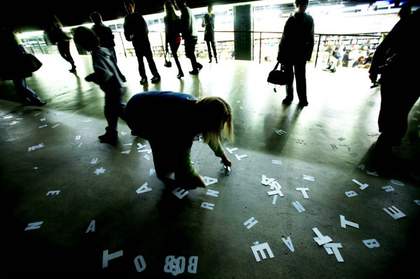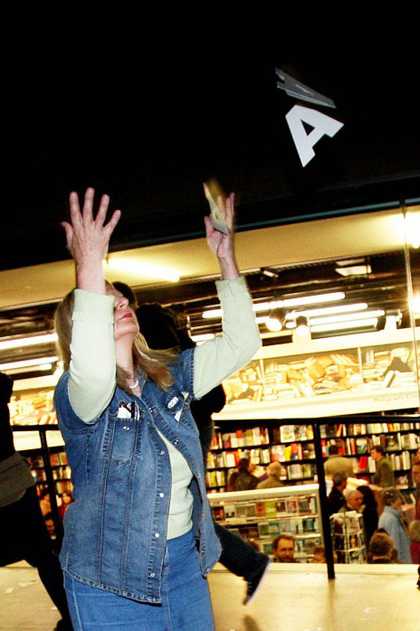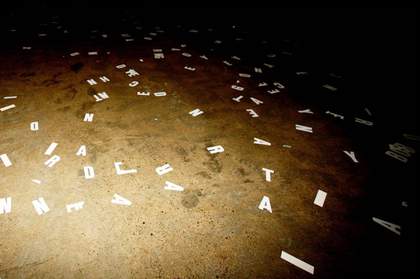Ewa Partum’s Visual Poetry was commissioned as part of UBS Openings: Saturday Live, a series of bi-monthly live performance events at Tate focusing on contemporary cultural practice. This particular edition of Saturday Live, subtitled Word Sculpture, focused on the use of language in contemporary art practice and also featured a live poetry reading by Carl Andre and a lecture-performance by Martin Creed. By juxtaposing different forms of word sculpture by these three artists, the Saturday Live programme sought to consider language as a material for making art. At the same time, in each case, there was a productive and irresolvable tension between the presentation of words as a visual or aural artefact and their meaning.
Partum’s Visual Poetry was performed at 16.30 on the ramp in Tate Modern’s Turbine Hall. The work lasted approximately thirty minutes, during which time Partum glued down and freely scattered thousands of white, cut-out letters across the floor of the space, positioning them into words and other patterns, shapes or arrangements. Following this solo performance the audience were invited to take part, using the letters to construct their own visual poetry. Adults and children participated by writing their names or messages with the letters throughout the Turbine Hall. They also arranged themselves on the ground beside the cut-outs, allowing their bodies to become extensions of the poems and elements of an expanded visual language. The visual poems were spread across the floor, thrown in the air and laid out on the bodies of the artist and the audience. Partum tossed individual letters above her head, creating small, floating visual poems, before launching swathes of the cut-outs from the balcony onto the larger space of the Turbine Hall below.
The Tate performance was a re-creation of an earlier work by Partum, titled Active Poetry, performed in Poland in 1971. For this the artist cut up a single page of James Joyce’s novel Ulysses and scattered the individual letters in a pedestrian arcade in Warsaw. The letters became distributed through the space creating new texts and chance meetings as passers-by moved around the arcade. It was described at the time by the literary critic Marek Ławrynowicz as revealing ‘that a poet’s activity does not have to be reduced only to the verbal sphere, but can have a situational character as well’. The concept marked a turning point in Partum’s career and is one with which she has continued to play in order to critique the means and modes of textual production.1 Partum went on to create a series of works using letter cut-outs, often releasing them into natural spaces, including the ocean and a hilltop. These free-form, action-based works enacted what Partum saw as a feminist critique of the patriarchal structures at the heart of language by resisting the rules of grammar and the traditional linear structure of text, allowing the work instead to be shaped by coincidence, the environment and the movement of the body.
A film documenting Partum’s 1973 performance of Active Poetry was shown in Tate Modern’s Starr Auditorium on 25 November 2006, as part of the Image/Text film programme commissioned to accompany the Word Sculpture performance events. The film screening illuminated the contrasting environments in which the earlier and later versions of this work occurred: one performed within the highly fraught context of the artist’s native Poland during a time of political and social upheaval, the other within an international art gallery. The former implicated an unknowing public, the other engaged a willing art audience; although in both settings a community was created through the experience of the work.
Clare Gormley
April 2016




